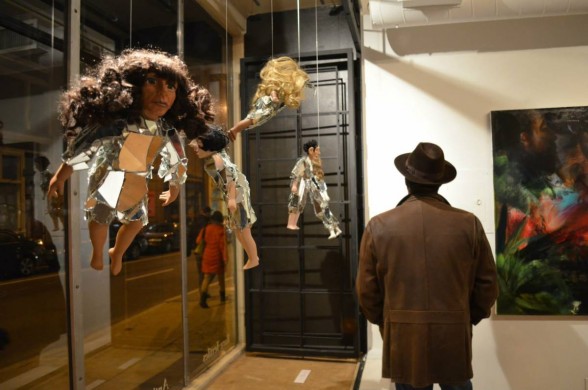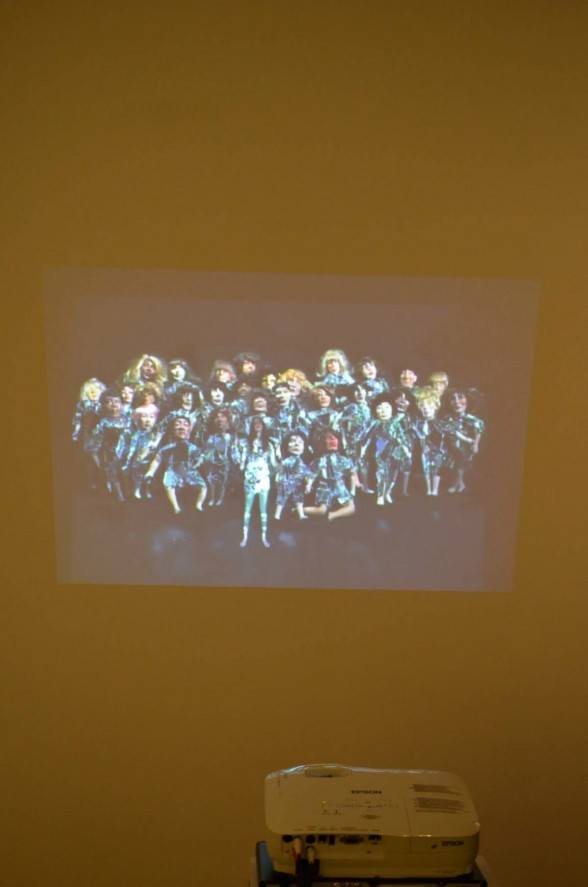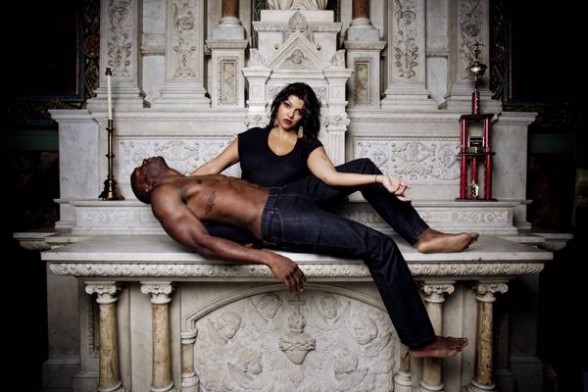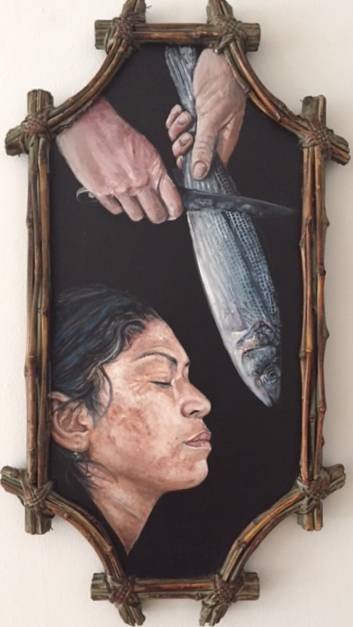[Jennifer works through a feminist, all-female show celebrating unconventional women and acknowledging the daily struggle of women in some cultures to be equally acknowledged. — the Artblog editors]
Zabardust is an Urdu term that can be translated into English to mean awesome, terrific, or even fabulous. It is also the conceptual framework and title for the current group show at Twelve Gates Arts, on 2nd street in Old City, Philadelphia. Organized by New York-based curator Jasmine Wahi, Zabardust includes various-media works by seven artists: Karlito Miller, Rachel Mason, Maria Berrio, Angela Fraleigh, Anjali Bhargava, Swati Khurana, and Leila Lal. The exhibition statement tells us that the sculptures, photography, video, paintings, and collage here all reference a larger narrative about the zabardusti of unconventional women and female empowerment.
Seeing ourselves in sculpture

Some works and artists fit into this concept more obviously than others. The classical rendering and lush, layered richness in the large oil paintings by Moravian College painting professor Angela Fraleigh lend a glory and power to her depicted female subjects. Rachel Mason’s doll sculptures suggest connections between viewers and unconventional and noteworthy historical and present-day women, Ana Mendieta, Beyoncé, and Eva Hesse among them. The sculptures have portrait heads modeled to resemble the faces and hair of the famous women; their bodies are formed by mirror shards in which we can see our own reflections. Perhaps this offers opportunities to see ourselves in or on these great women, or reflect on them, their contributions, and their history.
In many ways, these dolls recall projects by classic Feminist artists who also documented and provided much-needed opportunities to know and appreciate significant women. In these ways, Mason’s dolls support the curatorial vision. Because the dolls hang in the front window of the gallery, there are, at times, more distractions than opportunities for intimate reflection.

However, these sculptures become much more interesting when seen in Mason’s video, “StarSeeds,” on view across the gallery. In the video, Mason appears as a miniaturized version of herself standing on a stage with a large group of women-doll sculptures behind her; their reflecting, shiny bodies form a silvery mass out of which their idiosyncratic heads pop up. Mason herself is an unconventional woman, with Internet reports stating that she was kicked out of UCLA for scaling a campus building without safety equipment; she seems just right for inclusion in this exhibition. Her other well-known works and videos, such as FutureClown’s Filibuster and Never Let Me Down Again, not included in this show but available on her website, further evince the fascinating eccentricities of this artist and her practice.
Taking aim at “traditional” women’s duties

Large-format photographs by Anjali Bhargava and Swati Khurana, such as “The Least Dutiful Wife” and “The Least Orthodox Goddess,” relish unconventionality, but only if considered as arising in response to very traditional views about women’s roles. Swati Khurana is the wife in “Least Dutiful Wife”; she lounges among books and many cups of tea, presumably shirking other more traditional “wifely” duties.
The “Least Orthodox Goddess” seems to counter typical expectations of a white, European Virgin Mary. By placing an everyday woman in the role of the Virgin, the artists may be elevating the status of all women. This strategy is also reminiscent of classic Feminist art; Yolanda Lopez’s “Portrait of the Artist as the Virgin of Guadalupe” comes to mind. The narratives here were staged by Anjali Bhargava in response to trophies made by Swati Khurana; we can see these trophy sculptures on the edges of the photograph. The trophy inscriptions are the same as the titles of the photographs themselves. These works seem to ask: If every Little Leaguer these days receives a trophy regardless of their status as winner or loser, then why shouldn’t transgressing women receive such awards, too?

A secondary theme that emerges in Zabardust is an East/West cultural fusion, and this is most clear in works such as “Rekha,” a lightbox photograph by artist Leila Lal. This image stems from a scene from the 1981 Bollywood film “Umrao Jaan,” starring Rekha, a famous Indian film star who is shown in a setting that is both Renaissance chapel and Mughal palace. Is Rekha a woman of two cultures, of many cultures?
These amalgamations exemplify Twelve Gates Arts itself, a gallery devoted to supporting and exhibiting work by artists from or with cultural roots in South Asia, or who investigate cultural and geographic boundaries. Maria Berrio’s “I Am Your Food” and “I Am Your Air” extend the cultural horizons of this show by bedazzling, with rhinestones and collage elements, portraits of people of indigenous South American descent. The figures appear against a flower-patterned background and hold babies whose mouths are open to receive the food or air, as well as the traditions and cultures, offered by the people in the portraits.

Other works in Zabardust fit into the overall theme of empowerment and awesomeness more awkwardly, but are no less important in their didactic messages. A painting by Karlito Miller, for example, is a curious mix of imagery: a profile portrait of a women and a fish being cut or filleted with a long knife. This work is titled, “Six Out of Ten (women are sexually abused while crossing the border)”. The title brings to light a dire situation for women, but overall the painting seems to be an outlier in a show about fabulosity. Upon further reflection, however, maybe the border-crossing women that Miller is bringing to our awareness are even more heroic than the famous actresses, artists, or housewives featured in other works here.
On Feb. 28, Twelve Gates Arts, along with Drexel University’s Westphal College of Media Arts & Design, will host 12 Gates Video Arts Festival, featuring “experimental, queer, poetic, abstract, political, philosophical, uncensored, and mixed media short film and video” by artists from South Asia and the Middle East.
Zabardust remains on view through Feb. 28 at Twelve Gates Arts.










